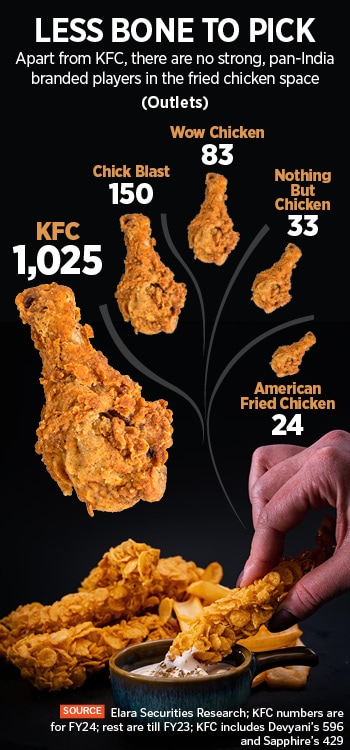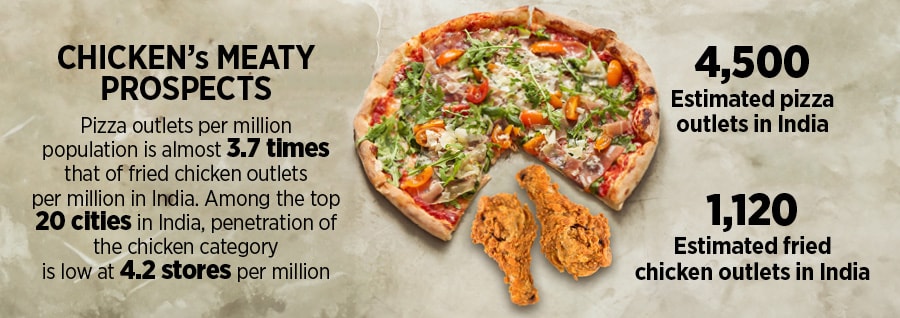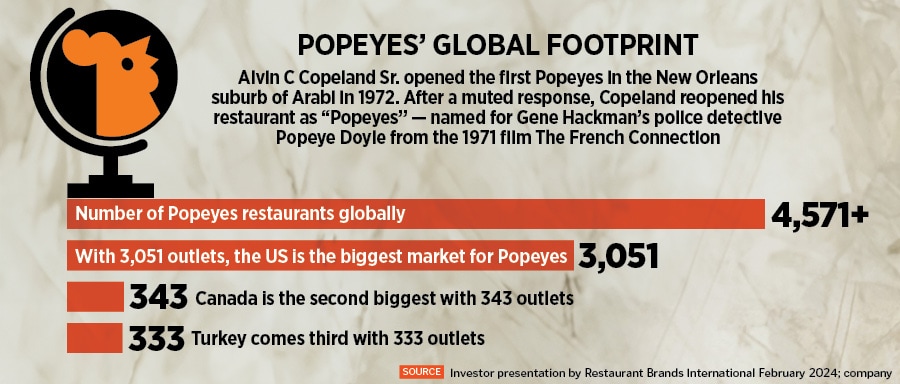Can Popeyes take on KFC in India?
Last October, Popeyes overtook KFC to become the second-biggest chicken chain in the US. Back home in India, the fried chicken upstart has aggressively ramped its footprint over the last two quarters.


Gaurav Pande starts the ‘crunchy’ conversation by underlining an elementary rule: Don’t count your chickens before they are hatched. Interestingly, the executive vice president and business head of Popeyes India counted his chickens for 12 months before deciding to step out of Bengaluru. Launched by Domino’s Jubilant FoodWorks—the master franchise of Domino’s and Dunkin in India—in January 2022, the Louisiana fried chicken brand remained confined in the QSR capital of India for over a year and then moved into Chennai in February 2023.
Sixteen months later, the second-biggest chicken chain in the US has galloped to 42 outlets across 15 cities. “It takes time to win consumer experience," reckons Pande, who shares a not-so-secret formula behind the crunchiness of the Louisiana chicken brand. “We marinate chicken for 12 hours," he claims. Chicken, Pande lets on, is marinated in Cajun seasoning, hand-battered, and breaded for the perfect shatter crunch. “We offer antibiotic-free chicken and fresh chicken," he claims. “The chicken is marinated for 12 long hours," he reiterates.

 Twelve months is what it took for Popeyes to step out of its first city. The sedate innings, however, has gathered pace over the last three quarters, and the brand plans to open 50 more stores in FY25. Interestingly, the medium-term target for store expansion is 250, according to the latest investor presentation by Jubilant FoodWorks. Pande decodes the sense of urgency by explaining why the brand took an inordinate time to expand. “The first year was focussed on perfecting the product," he says, adding that despite being the second biggest in the US—Popeyes overtook KFC to become the second-biggest fried chicken chain in America last October—the brand was entering a new country.
Twelve months is what it took for Popeyes to step out of its first city. The sedate innings, however, has gathered pace over the last three quarters, and the brand plans to open 50 more stores in FY25. Interestingly, the medium-term target for store expansion is 250, according to the latest investor presentation by Jubilant FoodWorks. Pande decodes the sense of urgency by explaining why the brand took an inordinate time to expand. “The first year was focussed on perfecting the product," he says, adding that despite being the second biggest in the US—Popeyes overtook KFC to become the second-biggest fried chicken chain in America last October—the brand was entering a new country.
A new country and a new brand needed a fresh approach. Sameer Khetarpal explains the differentiated strategy. “There were broadly four parameters to frame the expansion plan," says Khetarpal, who joined Jubilant FoodWorks as chief executive officer and managing director in September 2022. The first factor is demand. “We need to find if there is a chicken-eating market in that city," he underlined in the Q3FY23 earnings call in January. “So, 70 percent of Indians eat chicken. The proportion is larger in the South as compared to the western parts of India. So, we are aware of how big the market is," he said, alluding to the big opportunity in the fried chicken space. Bengaluru, interestingly, happens to be the biggest market for KFC, Domino’s, and a battery of QSR players, including Popeyes, which has 18 outlets in the city. The second factor for Khetarpal was the store economics. Return on investment (RoI), the payback period, the discipline of finding a store, and the rental negotiations stepped into the picture.
Next came the ability to serve the consumers. “We are the only player that offers fresh chicken," he claimed. The last factor was the ability to manage the operation. “You need to have a trained crew that knows how to fry, change the oil, and serve the customer," he concluded, highlighting the might of the American brand. “Popeyes is now the number two player in the US. So clearly, there is something. The bold Cajun flavours lend well to the Indian palates, and we have innovated fast," added Khetarpal.

The opportunity to make a dent in the fried chicken market is massive. The biggest reason is the absence of a strong No 2 pan-India player. With 1,025 outlets, KFC remains an undisputed big daddy of fried chicken in India. And Colonel Sanders has no potential threat from any player. A clutch of brands such as Chick Blast, Wow Chicken, Nothing But Chicken, and American Fried Chicken is too small to take on the biggest in India. Another tailwind for Popeyes is an under-penetration of meat QSR players in India. Look at the numbers.

Popeyes stands a meaty chance to ramp up scale in India. Pizza outlets per million population are almost 3.7 times of fried chicken outlets in the country. Among the top 20 cities in India, penetration of the chicken category is as low at 4.2 stores per million, according to ‘Hunger Games’, a QSR report by brokerage firm Elara Securities. In contrast, India has an estimated 1,120 fried chicken outlets, highlights the study released in February. “The chicken category—organised as well as unorganised—is buoyant and growing," reckons KS Narayanan, a food and beverage expert. While KFC leads in the organised category, the unorganised segment is dotted by thousands of small, mom-and-pop players who play price warrior and cater to the local palate. “Popeyes stands a good chance to make it big," he reckons, adding that even a burger player like McDonald’s was forced to enter the fried chicken segment by rolling out the product in South India. “Popeyes happens to be the right player at the right time to make most of the fried chicken boom in India," he adds. What, though, remains critical for the brand is to ensure profitable growth. “They need to fix the unit economics, and then expand," he sounds a word of caution.

For Popeyes, the big challenge is to ensure scale as well as consistency in the quality of the products. “QSR is a mass game. You need to be aggressive if you want to grow in India," says Ashita Aggarwal, professor of marketing at SP Jain Institute of Management and Research. The brand needs to maintain its promise of selling antibiotic-free and fresh chicken. “It’s tough to scale given the constraints of the supply-chain ecosystem in India," she says. Another challenge for the brand would be not to compete with KFC. The brand has been in India for close to three decades. “It takes years to understand the Indian consumer and tailor one’s offering," she says.

Khetarpal, for his part, is aware of the challenges. “We have to learn to walk before we can run. And that"s what we have done in the last couple of years," he underlined in the Q4FY24 earnings call in May. The brand has had its learnings, has fine-tuned its approach, and partnered with the global team to make an India-centric model. “We are confident of making Popeyes India’s fastest QSR to achieve revenue of Rs1,000 crore," he added.
First Published: Jun 05, 2024, 16:27
Subscribe Now